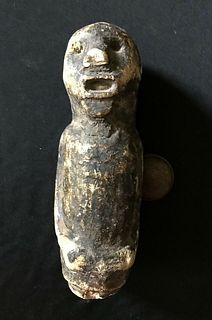Egyptian Late Dynastic Leaded Bronze Apis Bull
Lot 6
About Seller
Artemis Fine Arts
686 S Taylor Ave, Ste 106
Louisville, CO 80027
United States
Selling antiquities, ancient and ethnographic art online since 1993, Artemis Gallery specializes in Classical Antiquities (Egyptian, Greek, Roman, Near Eastern), Asian, Pre-Columbian, African / Tribal / Oceanographic art. Our extensive inventory includes pottery, stone, metal, wood, glass and textil...Read more
Estimate:
$1,000 - $1,500
Absentee vs Live bid
Two ways to bid:
- Leave a max absentee bid and the platform will bid on your behalf up to your maximum bid during the live auction.
- Bid live during the auction and your bids will be submitted real-time to the auctioneer.
Bid Increments
| Price | Bid Increment |
|---|---|
| $0 | $25 |
| $300 | $50 |
| $1,000 | $100 |
| $2,000 | $250 |
| $5,000 | $500 |
| $10,000 | $1,000 |
| $20,000 | $2,500 |
| $50,000 | $5,000 |
| $100,000 | $10,000 |
| $200,000 | $20,000 |
About Auction
By Artemis Fine Arts
May 20, 2021
Set Reminder
2021-05-20 10:00:00
2021-05-20 10:00:00
America/New_York
Bidsquare
Bidsquare : Ancient & Ethnographic From Around The World
https://www.bidsquare.com/auctions/artemis-gallery/ancient-ethnographic-from-around-the-world-6979
Ancient art from Egypt, Greece, Italy and the Near East, as well as Asian, Fossils, Pre-Columbian, Native American, African / Tribal / Oceanic, Fine art, and much more! All categories, all price ranges... all legally acquired and guaranteed to be as described or your money back. Artemis Fine Arts info@artemisfinearts.com
Ancient art from Egypt, Greece, Italy and the Near East, as well as Asian, Fossils, Pre-Columbian, Native American, African / Tribal / Oceanic, Fine art, and much more! All categories, all price ranges... all legally acquired and guaranteed to be as described or your money back. Artemis Fine Arts info@artemisfinearts.com
- Lot Description
Egypt, Late Dynastic Period, ca. 664 to 525 BCE. A fine Egyptian cast leaded bronze Apis bull standing with one leg stretched slightly forward presenting a naturalistic visage comprised of a broad snout with flared nostrils and a straight mouth, all flanked by a pair of petal-shaped ears and supported by a thick neck. A slender tail falls from the end of the ancient animal's lengthy body. Apis bulls were immensely important in Ancient Egypt and when one died, Egyptians would leave small votives, such as this, at the burial site. A rare and intriguing find! Size: 3.125" L x 0.75" W x 1.25" H (7.9 cm x 1.9 cm x 3.2 cm); 2.5" H (6.4 cm) on included custom stand.
Apis was originally worshipped by Narmer, the ruler who unified Upper and Lower Egypt around 3000 BCE - the sacred bull is shown trampling the pharaoh's enemies on the Narmer palette that commemorates the unification. Three thousand years later, by the time of Roman control of Egypt, the worship continued. Though centered around the city of Memphis, the cult of Apis was so extensive in Egypt that the Greeks and Romans wrote about it repeatedly. The famous French archaeologist Mariette, excavating at the Serapeum of Saqqara, found the mummified remains of more than sixty bulls, some buried in their own separate tombs.
Provenance: private Salisbury, Maryland, USA collection; ex-Paul Henri Lapoint Estate, Anno Moritis, 1980; ex-private Paris collection, acquired from 1940s to 1960s
All items legal to buy/sell under U.S. Statute covering cultural patrimony Code 2600, CHAPTER 14, and are guaranteed to be as described or your money back.
A Certificate of Authenticity will accompany all winning bids.
We ship worldwide and handle all shipping in-house for your convenience.
#163758Missing legs, horns, and headdress. Professional restoration to areas of legs and minor area of back. Expected abrasion and nicks, commensurate with age. Otherwise, very nice with lovely green and russet patina.Condition
- Shipping Info
-
All shipping is handled in-house for your convenience. Your invoice from Artemis Gallery will include shipping calculation instructions. If in doubt, please inquire BEFORE bidding for estimated shipping costs for individual items.
-
- Buyer's Premium



 EUR
EUR CAD
CAD AUD
AUD GBP
GBP MXN
MXN HKD
HKD CNY
CNY MYR
MYR SEK
SEK SGD
SGD CHF
CHF THB
THB













